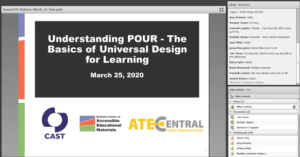Understanding POUR - The Basics of Universal Design for Learning

This webinar, made available by Internet Scout Research Group, features Rachel Bower and Luis Perez discussing how educators can increase the accessibility of high quality materials for learners with disabilities. Objectives for the webinar include:
- Explain what is meant by "accessible" and how accessibility fits into the Universal Design for Learning framework.
- Provide examples of the application of the four POUR principles in the context of a robotics curriculum.
- Identify AEM Center resources for further learning about accessible educational materials.
Background information is given on ATE Central, as well as the mission and goals for The National Center on Accessible Educational Materials (AEM) Center and CAST. The Universal Design for Learning (UDL) is defined as "a framework based on scientific insights into how humans learn that seeks to optimize instruction in order to allow every person to become an expert learner." The Web Content Accessibility Guidelines 2.1 from AEM use the acronym POUR (Perceivable, Operable, Understandable, Robust) to define the four qualities of an accessible user experience. Detailed instructions are given on how POUR can be used to create accessible educational materials, including: Mark up the Document With Styles, 3 Benefits of Using Styles for Section Headings, Styles Should Follow a Logical Order, Check Your Work, Use of Table Headers, and more. The recording runs 1:01:41 minutes in length and .pdf of the presentation slides is also included.
About this Resource


Comments